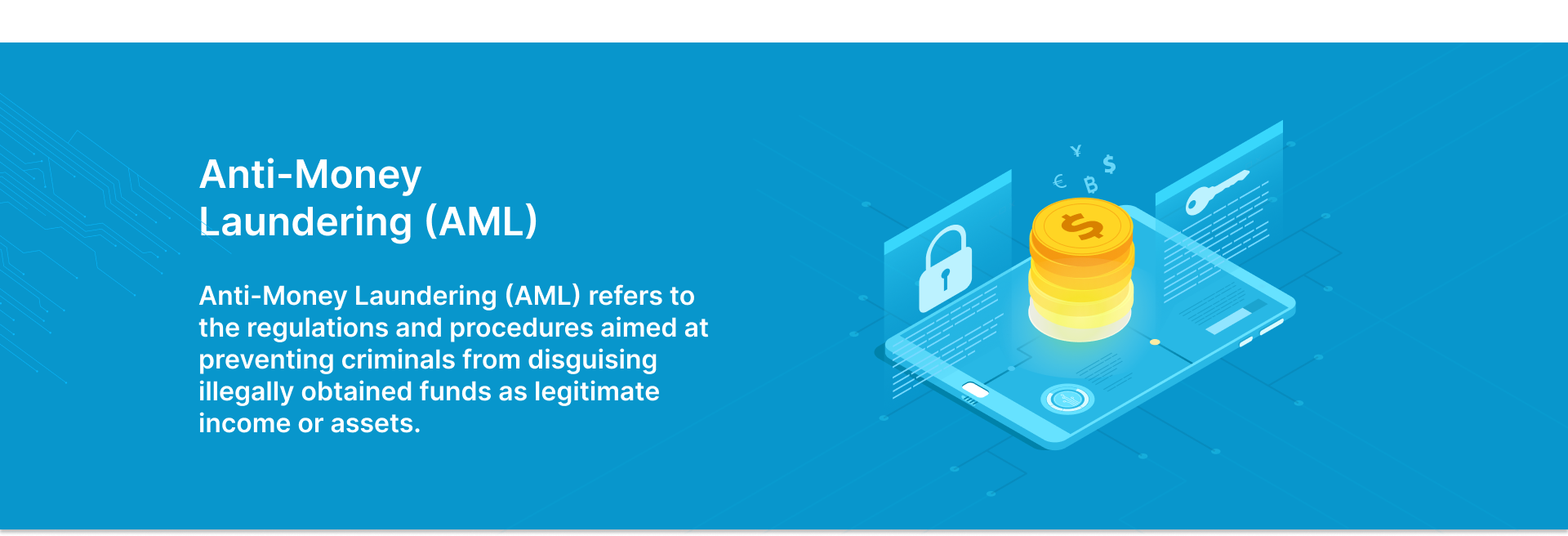
What is Anti-Money Laundering (AML)?
In the complex world of financial transactions, the term “Anti-Money Laundering” (AML) emerges as a shield against illicit financial activities. The laws, rules, and practices known as anti-money laundering (AML) are intended to stop criminals from passing off money they have gotten unlawfully as legitimate earnings. AML includes banks, governments, and international organizations in the complex fight against financial crime. This blog post will focus on the intricacies of AML, the mechanisms it employs, and its importance in grasping the bigger picture of financial security and integrity.
What is Money Laundering?
Money laundering is the illicit practice of disguising substantial sums of money obtained through criminal activity—such as the support of terrorism or drug trafficking—as coming from a lawful source. The money obtained through illicit means is seen as “dirty,” and in order to make it appear “clean,” it is “laundered.”
The laundering process typically involves three steps:
Placement. The illicit funds are introduced into the legitimate financial system.
Layering. To hide its source, the funds are moved or transferred between several bank accounts and financial instruments.
Assimilation. The money seems to be legitimate when it returns to the economy and can be utilized for authorized purposes.
The goal of anti-money laundering initiatives is to stop and identify this kind of financial crime. They take several forms, from keeping an eye on and reporting questionable transactions to making financial institutions follow the law. In order to prevent the financial system from being misused for money laundering, AML regulations mandate that financial institutions keep records, disclose specific transactions to government agencies, and do due diligence on customers.

Who is Using AML?
Many organizations in the banking industry and beyond make advantage of AML legislation. These are the main users:
Financial institutions. AML procedures are used by banks, credit unions, and other financial organizations for transaction monitoring, reporting of suspicious activity, and client due diligence.
Regulatory bodies. Government agencies and international organizations enforce AML laws and guidelines, ensuring compliance among financial institutions.
Law enforcement agencies. These organizations cooperate with financial institutions to track down illicit funds and look into money laundering operations.
Businesses. AML controls are also used by non-financial companies to stop money laundering, particularly by those that trade in high-value products like luxury automobiles, real estate, and artwork.
Individuals. AML procedures must be implemented and managed by compliance officers, auditors, and other experts working for firms.
AML is a global collaborative effort to protect the financial system and fight financial crimes.
What is AML Compliance and Why is it Important?
The laws, rules, and practices known as AML compliance are meant to deter people and companies from participating in money laundering activities. Financial institutions and other regulated companies must abide by these regulations.
Why is AML Compliance Important? Here are the main reasons:
Stopping crime. It hinders illegal activity by making it more difficult for criminals to conceal illicit gains.
Safeguarding monetary institutions. Banks and other organizations are shielded from being used as conduits for money laundering.
Maintaining integrity. It maintains the integrity of financial markets by ensuring they are not corrupted by illicit funds.
Economic stability. It enhances the general stability and reputation of the financial system by discouraging financial crime.
Legal obligations. Serious consequences, such as fines and sanctions for both individuals and institutions, may follow non-compliance.
International standards. It facilitates enterprises’ and nations’ coordination with global initiatives to combat financial crimes.
In essence, AML compliance is essential to preserving a secure and stable financial environment on a national and worldwide scale. It plays a crucial role in the struggle against international financial crimes, terrorism financing, and corruption.
What are the Stages of AML?
CDD, or customer due diligence
In this phase, customers’ identities are identified and confirmed, their risk profile is evaluated, and their transactions are watched for questionable activity.
Tracking of transactions
During this phase, real-time transaction monitoring is done to look for any odd or suspect trends that might point to money laundering or terrorism financing.
Suspicious Activity Reporting (SAR)
The financial institution or other reporting body must submit a Suspicious Activity Report to the relevant authorities if suspicious activity is found during transaction monitoring.
Maintaining Records
For a predetermined amount of time, financial institutions must keep accurate and current records of all customer transactions and due diligence activities.
Monitoring and reporting on compliance
This phase entails reporting as well as continuing policy and process monitoring and review for AML.
Key AML Acts
Anti-money laundering (AML) key acts are laws and regulations that aim to prevent and detect money laundering and terrorist financing activities. Some of the most important AML key acts include.
USA PATRIOT Act. In reaction to the terrorist acts of 9/11, the United States passed this act, which contains provisions meant to bolster the nation’s anti-terrorism financing and AML policies.
Financial Action Task Force (FATF) recommendations. An intergovernmental organization called the FATF establishes global guidelines for thwarting the funding of terrorism and money laundering. In many nations, its guidelines are regarded as essential points of reference for AML laws.
Bank Secrecy Act (BSA). A U.S. legislation known as the BSA mandates that banking institutions report specific transactions and save documents that could be helpful in the fight against money laundering.
European Union AML Directives. The EU has issued several directives that set out AML requirements for member states, including customer due diligence, record-keeping, and reporting obligations.
Financial Crimes Enforcement Network (FinCEN) regulations. FinCEN is a bureau of the U.S. Department of the Treasury that is responsible for enforcing AML regulations and combatting financial crimes.
Proceeds of Crime Act (POCA). This is the UK legislation that provides the legal basis for the recovery of criminal assets, including those generated through money laundering.
Financial institutions must abide by the rules outlined in these laws in order to avoid and identify suspicious transactions. These important acts contribute to the establishment of the legal framework for combating money laundering and terrorist financing operations.
What is the Difference Between AML, CDD, and KYC?
In the fight against financial crimes and money laundering, the financial sector relies heavily on AML, CDD, and KYC. This is how they vary:
AML (Anti-Money Laundering)
AML is a broad framework of laws, regulations, and procedures intended to prevent criminals from disguising illegally obtained funds as legitimate income. It encompasses a range of activities including monitoring, detecting, and reporting suspicious transactions.
CDD (Customer Due Diligence)
For AML policies to be implemented properly, CDD is a crucial component. It entails confirming the legitimacy of clients and evaluating their risk profiles. In order to make sure a consumer is not engaged in any illegal activity, institutions use the CDD procedure to collect and assess pertinent information about them.
KYC (Know Your Customer)
One of CDD’s components is KYC. It particularly refers to the actions done by financial institutions to verify the identification of their clients, comprehend the nature of their business dealings, and make sure such dealings are lawful. Regular maintenance and updating of customer information is another function of KYC procedures.
AML is the overarching set of standards for preventing money laundering, CDD is the process of collecting and analyzing customer data as part of AML, and KYC is the ongoing practice of verifying the identity and activities of customers. Each plays a distinct role in safeguarding the financial system against illicit use.
Learn more about KYC here:
AML Application Industries
Applications for anti-money laundering are critical for a number of industries to fight financial crimes and comply with regulations. These are a few sectors that use AML applications.
Cryptocurrency
With the rise of digital assets such as Bitcoin and Ethereum, cryptocurrency exchanges and wallets must implement AML measures to prevent money laundering and terrorist financing. AML applications help these platforms verify customer identities, monitor transactions for suspicious activities, and report any unusual behavior to regulatory authorities.
Financial Institutions
Banks, credit unions, investment firms and other ficancial institutions are primary targets for money launderers due to their access to large amounts of funds. AML applications enable these institutions to conduct customer due diligence, monitor transactions in real-time, and file suspicious activity reports to regulatory authorities. Failure to comply with AML regulations can result in hefty fines and reputational damage.
Designated Non-Financial Businesses and Professions (DNFBPs)
Casinos, real estate agencies, accountants, lawyers, precious metals dealers, and virtual currency exchanges are also required to implement AML measures to prevent criminals from using their services for illicit purposes. AML applications help DNFBPs conduct customer due diligence, monitor high-risk transactions, and comply with reporting obligations to regulatory authorities.
AML applications play a crucial role in various industries to detect and prevent money laundering, terrorist financing, and other financial crimes. By leveraging technology and automation, businesses can strengthen their AML compliance efforts and protect themselves from regulatory scrutiny.
Conclusion
Anti-money laundering refers to the regulations and processes put in place to prevent the illegal movement of funds and ensure the integrity of the financial system. The purpose of AML laws is to identify and prevent financial crimes, including financing of terrorism. Financial institutions can contribute to the fight against these illicit activities and safeguard the international financial system by adhering to AML requirements. To stop illegal activity and protect the integrity of the financial sector, it is essential that individuals and businesses comprehend and abide with AML regulations.